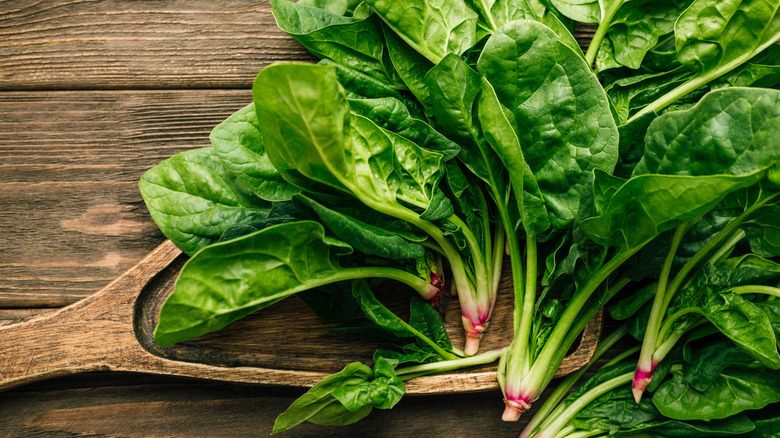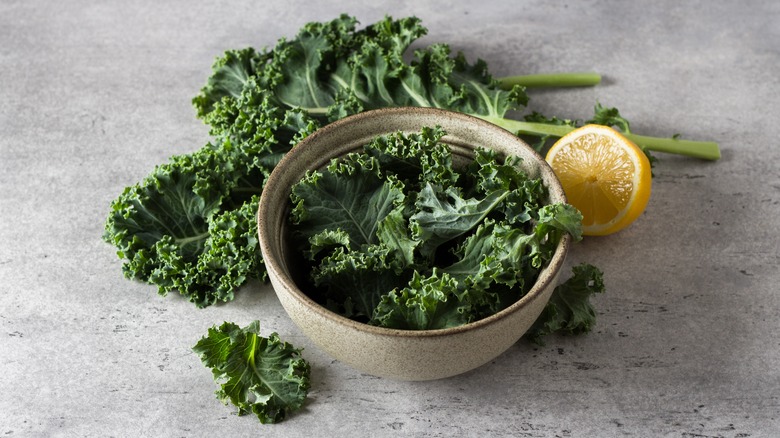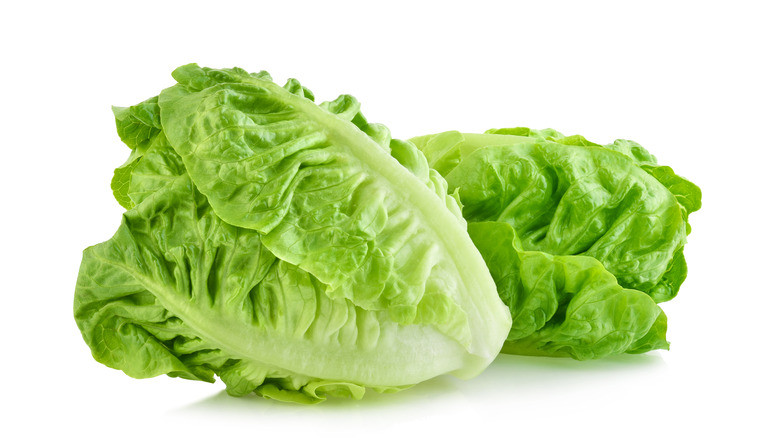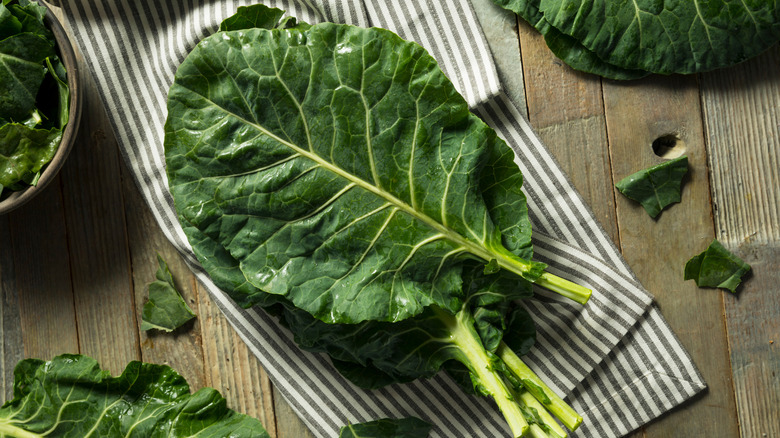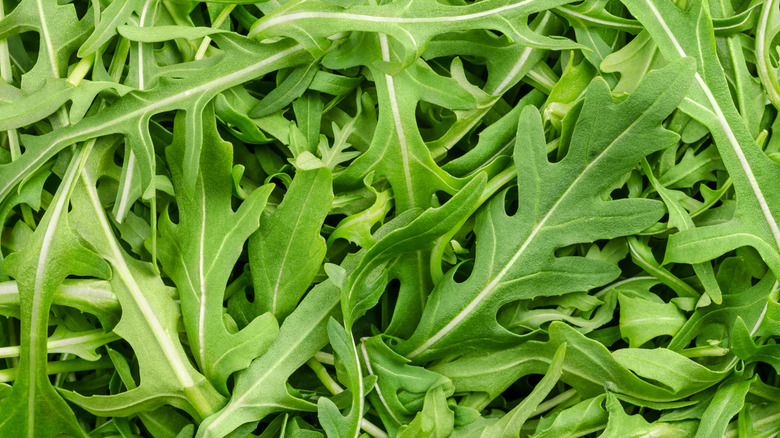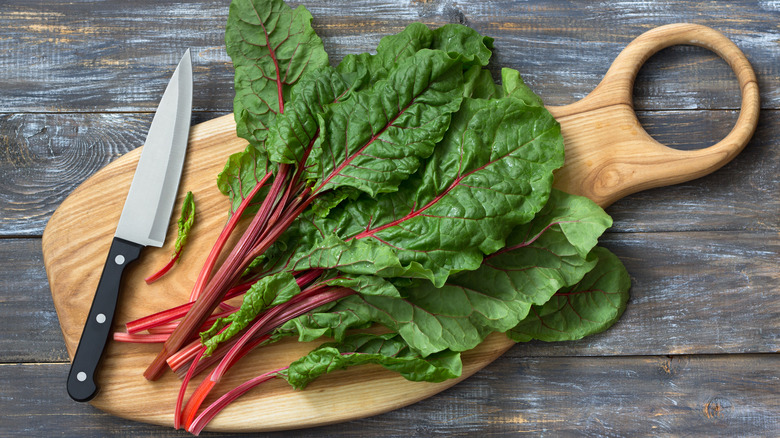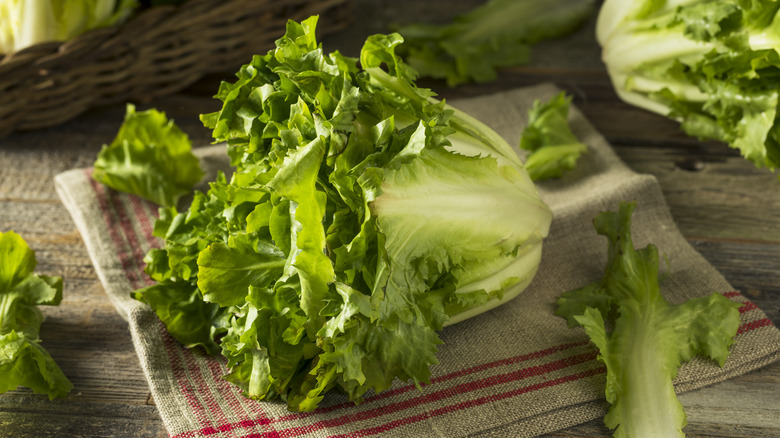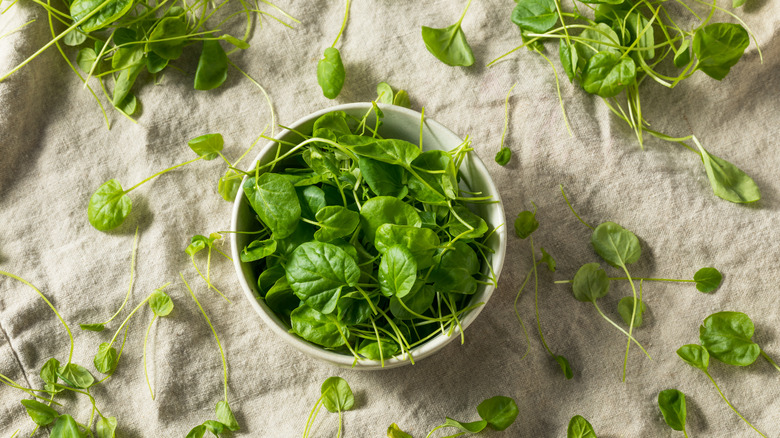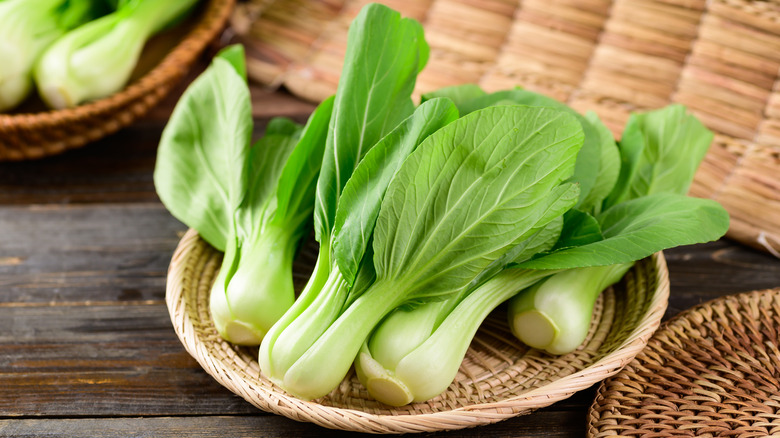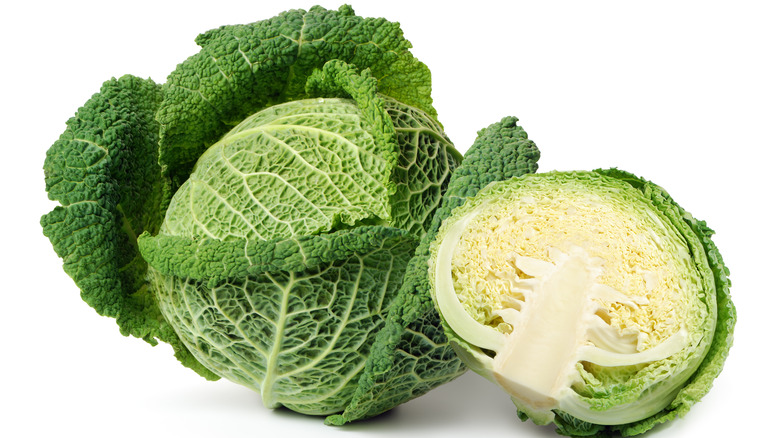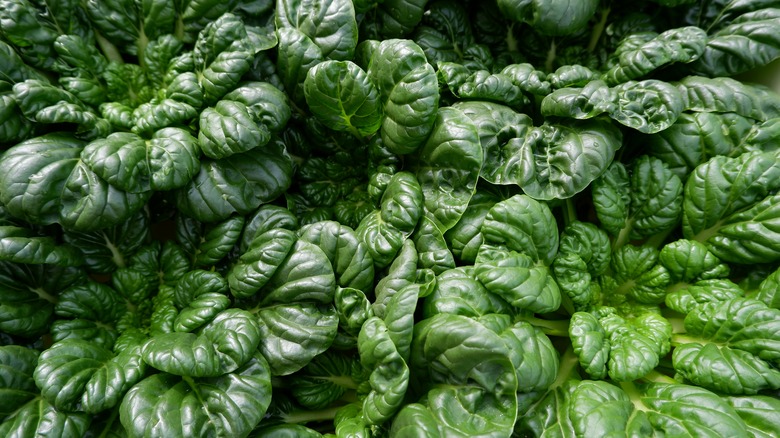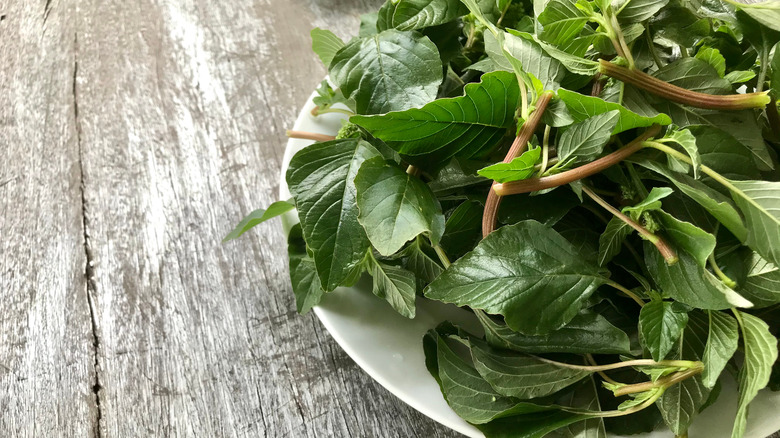12 Best Substitutes For Spinach
With its brilliant green leaves and agreeable earthy flavor, spinach is one of the few edible plants with a prominent place in history, pop culture, and cuisines around the world. Long before a certain cartoon sailor popularized it, this unassuming member of the amaranth family graced the plates of royals and peasants alike. Centuries of cultivating this cool-weather crop resulted in four main varieties (smooth-leaf, savoy, semi-savoy, and baby spinach) that are available year-round and used in all kinds of recipes ranging from salads and juices to soups, quiches, and dips.
In addition to its culinary versatility, spinach is a nutrition powerhouse. According to Healthline, it contains high amounts of vitamins K, C, and A, as well as magnesium and potassium (think of these as "building blocks" for cells). Spinach also contains folate, which helps keep our cells strong and healthy. And if you don't happen to have this vegetable on hand, the great news is that there are plenty of alternatives that make excellent dietary sources of all these nutrients and can be incorporated into any dish. So whatever your reason for substituting spinach might be, doing so is a great way to get acquainted with different leafy greens, explore their culinary potential, and reap the health benefits.
1. Kale
One of the most talked-about leafy greens of the past decade, kale is a major player in the health food market. This isn't surprising, considering it is one of the most nutrient-dense vegetables in the world, packed with vitamins K, A, and C in quantities exceeding recommended daily values. To get the most out of its nutritional value, Healthline recommends consuming it raw.
Even though over a dozen varieties of kale are available year-round at U.S. supermarkets, like all other crops, it tastes best when fresh and in season. The vegetable is a cool-weather crop that thrives in winter, with the peak season running between November and April, so now would be the best time to use raw kale to replace spinach in a salad or a smoothie. However, if you're not a fan of its unabashedly healthy, slightly bitter flavor, cooking helps reduce it. NutritionFacts.org points out that frozen kale, surprisingly, has a 60% higher antioxidant capacity than fresh, and blanching or steaming (rather than boiling) increases it even further. Thus, you could always opt for it when replacing spinach in casseroles, soups, or recipes that specifically call for frozen greens, like spanakopitas.
2. Romaine
Romaine is a member of the lettuce family, revered for its mild, refreshing flavor and crisp texture. Considering it's the second most popular lettuce in the U.S., chances are you have seen its loaf-shaped heads around. While it might be the top choice for Caesar salad, it could effortlessly act as a spinach substitute in other salad recipes. Embrace the upcoming winter by using the heat-tolerant romaine leaves instead of spinach in a roasted fennel and grapefruit salad recipe.
Spinach is the richest plant source of folate (also known as vitamin B9) — an essential nutrient in red blood cell production and healthy pregnancy. But of all other leafy greens, romaine is next in line. According to the National Institutes of Health, ½ cup of boiled spinach contains a whopping 33% of the recommended daily intake. In contrast, a cup of shredded romaine contains a decent 16% folate, which is more than the daily value of a cup of raw spinach. Additionally, romaine boasts a high vitamin A, C, and K content, making it a healthy spinach alternative.
3. Collard greens
You might know them as a staple of Southern cuisine. Still, with their unobtrusive flavor, collard greens are a versatile ingredient and an excellent substitute in various dishes that call for cooked greens, such as creamed spinach. A close relative of kale, collards are almost every bit as nutritious, containing high amounts of vitamins K, A, and C, as well as B9, calcium, and manganese. Their leaves are typically wider, and the stems are tougher than those of kale and therefore require finer slicing (if eating raw) and longer cooking times.
While the consensus is that cooking leafy greens adversely affects their nutritional value, particularly vitamin C content, collard greens are so high in it that they retain a decent amount even after heat treatment, per NutritionFacts.org. So the next time you crave a hearty bowl of traditionally spinach-heavy saag paneer, try collard greens as a nutritious alternative.
4. Arugula
Rucola, rocket, colewort, roquette, Italian cress — this vegetable has many names. A member of the mustard family, arugula is known for its delicate flat leaves and signature peppery taste. Like other leafy greens, it is rich in vitamins A, K, and C, as well as potassium and calcium. But unlike others, arugula has the highest amount of nitrates, which help dilate the arteries, let oxygenated blood flow to your muscles, and positively influence your energy levels (via "How Not to Die: Discover the Foods Scientifically Proven to Prevent and Reverse Disease"). According to Medical News Today, it also has glucosinolates that cause its bitter taste and may actually have cancer-fighting abilities when broken down by our bodies.
It's not an ideal 1:1 substitute for spinach in terms of flavor, considering the latter is a much milder-tasting green, but arugula could be used in its place as a topping for sandwiches and pizza. Additionally, it could be utilized in small amounts combined with other, milder-tasting greens in salads or pureed into a green pesto. If you want to make the flavor tamer, even the briefest cooking will help, so incorporating a few leaves into a tofu scramble might be a good idea. But if you're one of those people with what the Independent called "rocket gene" and absolutely can't stand arugula's flavor due to genetic predisposal, it would be best to pick another spinach substitute.
5. Chard
Unlike its relatives in the beet family, Swiss chard has always been cultivated for its leafy stalks rather than nutritious roots. There is evidence of it being used the same way as spinach since at least the mid-19th century. A Dictionary of Modern Gardening states that the leaves of chard, then known as white beet, were boiled or used in soups, just like spinach would be (whereas the stalks of the sweet white beet variety were cooked similarly to asparagus and known under the name "chard").
Today, various chard cultivars, boasting red, white, yellow, or green stalks, are rich in vitamins K, A, and C, manganese, potassium, calcium, iron, and fiber, as well as beneficial antioxidants. However, on par with spinach, the vegetable is a high-oxalate green, meaning it has low calcium bioavailability and presents health risks to those with kidney problems (via NutritionFacts.org).
Cooking reduces the bitterness and the oxalate count of chard, so if you don't have a history of kidney problems, it is safe to use it in any recipe that calls for cooked spinach. If you plan on using raw chard as a spinach substitute in salads or other dishes where you want fresh greens, opt for the green stalk variety, dubbed "butter chard" due to its milder taste and bitterness (via Specialty Produce).
6. Escarole
This versatile member of the chicory family has been enjoyed since ancient times and widely cultivated in Europe for at least five centuries, earning a special place in Italian and English cuisine (via The Ecology Center). Compared to curly endive (another kind of chicory which it is often confused with), it has a milder, less bitter taste and smooth, moderately broad leaves, which make it a perfect salad base. Consuming it this way is also the most nutritious — according to Healthline, just two cups of raw escarole pack 164% of the daily recommended value for vitamin K, 58% for vitamin A, and 30% for folate.
Escarole is often lightly cooked when used in warm salads, making its flavor even milder. However, if you're replacing spinach with this raw vegetable in a salad, use the lighter-colored inner leaves, and pair them with sweet ingredients, like apples or beets, to balance out the bitter flavor. Alternatively, combine it with a salty dressing, as salt is known to suppress our perception of bitterness (via CHIMIA International Journal for Chemistry). Cooking escarole lends just enough flavor without overpowering the whole dish, so it would make a perfect substitute for cooked spinach in Italian wedding soup or any other hearty recipe.
7. Beet greens
While the hand-staining roots of beets are commonly used in cooking, the leaves and stalks are often overlooked. However, buying the vegetable with its greens helps you determine the freshness and overall condition (tip: look for firm stalks and green leaves) and gives you an excuse to incorporate them into your diet, as well as lower food waste. Even if you can only find the roots, slicing the tops off and placing them in water is a surefire way to grow your own beet greens for no extra charge.
Whether store-bought or homegrown, these vegetables can be used much in the same way as spinach. If you have a big bunch at your disposal, The Vegan Atlas recommends lightly steaming or sauteeing them in place of cooked spinach. Like the other substitutes, they retain a high amount of nutrients even when heated. Besides the obvious high vitamin K and A content, one cup of boiled beet greens contains more potassium and copper than an equal amount of cooked spinach.
However, despite their high vitamin content, beet greens are best enjoyed in moderation. Together with spinach and chard, its two close relatives, they form the high-oxalate trio, which means it's best to cook them in water (which absorbs 60% of the oxalates and should then be discarded) before consumption (via NutritionFacts.org).
8. Watercress
Even though watercress, which gets its name from the watery beds it is cultivated in, is the most common, it is just one of many varieties. All of them belong to the mustard greens family, making them a close counterpart to arugula. Both are small-leaved, pungent, and peppery tasting, most often enjoyed raw in small quantities. The nutrition profile of watercress is also similar to arugula and other leafy greens, but what makes it stand out is its high amount of phenylethyl isothiocyanate (PEITC), a compound known for its cancer-fighting potential (via The Watercress Company).
When choosing the perfect bouquet of this delicate green at the store, follow the same rules you would for spinach: focus on the ones with perky, glossy, dark leaves free of yellowing or slimy bits. Raw watercress can be used alongside a milder leafy green in an almond mint pesto or a Moroccan chickpea salad as a spinach substitute. But if its signature flavor isn't your cup of tea, use it in recipes calling for cooked spinach, including those for sauces, soups, and pasta.
9. Bok choy
This member of the cabbage family is a staple of Chinese and other Asian cuisines, revered for its pleasant color and elegant shape to the point of becoming immortalized in jade and showcased in museums (via Gastro Obscura). In its plant form, bok choy spread across the globe in the 19th century, when Chinese immigrants, who used it both in cooking and for its medicinal properties, introduced the crop to the U.S. and the Caribbean (via FoodPrint). In addition to its flavor properties, it is prized as one of the low-oxalate greens rich in calcium. Today, most bok choy is imported to the U.S. from Mexico. Still, about a third of it is grown locally, primarily in California, and is available in supermarkets year-round, with peak season occurring during winter (via Houstonia).
Baby bok choy is an early harvested, smaller vegetable that makes an excellent raw spinach substitute. Its tender leaves, crispy stalks, and delicate flavor make it ideal for salads or other dishes where a refreshing crunch would be appreciated. Of course, full-grown bok choy can also be enjoyed raw, but blanching or stir-frying turns it tender and flavorful. Moreover, it's a common ingredient in Asian-inspired soups, so next time you stumble upon a vegetable wonton soup recipe that calls for both spinach and bok choy, you can safely substitute one for the other. Additionally, if there are any damaged or unused stalks, you can freeze them for your next veggie scrap broth.
10. Savoy cabbage
While flat-leaf baby spinach might be the most popular choice for salads and other dishes relying on its fresh crunch and mild flavor, some recipes might call for what is known as savoy spinach. This variety is known for its crinkly leaves and bitter taste, making it better suited for cooking than enjoying raw. An excellent substitute for this type of spinach is savoy cabbage. Granted, it's not as much of a nutritional powerhouse, but it still packs a decent amount of vitamins K, C, and folate.
What makes it a good alternative is not its nutritional profile or similar name but rather its appearance and versatility. Savoy cabbage stands out among other members of its family thanks to its deep green crinkly leaves. Unlike other cabbages, which could also sometimes be used to substitute spinach in a pinch, it has a milder, almost sweet flavor that doesn't have those powerful peppery cabbage notes. In addition, it holds up in cooking without becoming a slimy mess, and its nutty taste is good enough to enjoy on its own. Thus, you could turn a garlic-sautéed spinach recipe into a beautiful savoy cabbage side.
Food and Travel Magazine recommends stir-frying it with ginger, chili, sesame, and soy sauce if you want to take it even further. Alternatively, you could add it to soups, lasagnas, or any other dish where you would use savoy spinach.
11. Tatsoi
Tatsoi is another cultivar of the Brassica rapa species with a Chinese heritage. English names for tatsoi include "spinach mustard" and "rosette bok choy," which should give you an idea of its appearance and flavor profile. A relatively new addition to the North American market, it's gaining popularity thanks to its delicate flavor, which ranges from earthy and nutty to lightly tangy, and its impressive nutritional profile.
Tatsoi is dubbed "vitamin green" for a reason. While it might seem too similar to bok choy in appearance and flavor, it actually has a higher vitamin A and C content, as well as more iron (per Dr. Axe). And if that's not enough, a 100-gram serving of tatsoi contains two times as much calcium as milk, according to Heal with Food. Combined with the lack of oxalates in spinach, this makes tatsoi an excellent source of calcium.
There are many ways to use this versatile green in cooking, from braising and steaming to pickling. Of course, its mild flavor and crunchy mouthfeel make tatsoi ideally suited to substitute baby spinach in any recipe where it would be used fresh. However, it would work just as well in an easy sautéed spinach soup recipe or in a stir-fry since heat lends tatsoi a pleasant buttery texture.
12. Amaranth greens
You might already be familiar with nutritious amaranth seeds — a close relative of quinoa used as a gluten-free alternative to grains. Amaranth greens, on the other hand, come from several different plant species within the same genus and can be used as an alternative to spinach.
Sometimes called "Chinese spinach," amaranth greens have a rich nutritional profile and have been used by the Chinese in medicinal ways. Today they are recognized as a great source of iron, potassium, and dietary fiber (via Specialty Produce). Compared to spinach, amaranth greens demonstrate higher counts of calcium, protein, and vitamin C (via Critical Reviews in Food Science and Nutrition). However, they also contain high levels of oxalates, so it is advised to boil them in generous amounts of water before consumption (via Garden Therapy).
As with most other leafy greens, it is best to save the more mature leaves for cooking and enjoy the younger, tender leaves fresh. Amaranth greens can replace spinach in any dish in a 1:1 ratio and would work especially well in a creamy dip or a hearty soup with plenty of other greens, such as Nigerian egusi.
